Common Minnesota Rocks
Throughout geologic time, Minnesota's landscape has undergone many changes. At times, high mountains lined the horizon. Later, vast seas engulfed the region. Still later, great sheets of ice covered the land. All of these environments are recorded in the rocks and sediments found around the state.
The following is a summary of the major rock types found in Minnesota in approximate chronologic order. Please note that a specific rock formation (if named) may not be the only example of a particular rock type in the state.
+
GNEISS
Gneiss
Some of the oldest rocks in the world include the gneiss found in the Minnesota River valley. The Morton Gneiss, which is 3.6 billion years old, is a coarsely crystalline, foliated metamorphic rock. The texture and mineral assemblage of the Morton Gneiss give clues as to how the rock formed. The fact that it is a crystalline rock with large visible grains indicates that it cooled or recrystallized slowly beneath the Earth's surface. The foliation, or alignment of the mineral grains, indicates that the original rock was subjected to great heat and pressure deep below the Earth's surface.
Gneiss is quarried for use as building stone and monuments. You can find outcrops of gneiss near Morton (the colorful "Rainbow Gneiss"), Redwood Falls, Sacred Heart, and Ortonville.
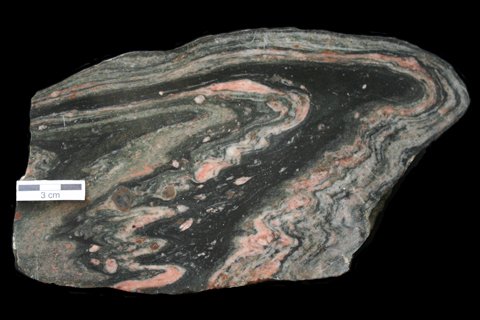

+
GREENSTONE
Greenstone
In Minnesota, greenstone is somewhat younger than the gneiss. Greenstone is a weakly metamorphosed basalt that is greenish to gray. This type of rock formed about 2.7 billion years ago, when the area that is now northern Minnesota was part of a volcanic island arc, much like the islands of Japan are today.
Greenstone and other associated volcanic and related rocks have been prospected for deposits of economic metals such as gold, copper, zinc, lead, and iron. Iron mines formerly operated in Ely and Soudan.


+
GRANITE
Granite
Granite is found throughout northern and central Minnesota. It varies in age from 2.6 billion years in the Minnesota River valley and northern Minnesota, to about 1.7 billion years near St. Cloud. Minnesota granites are composed predominantly of the minerals feldspar, quartz, mica, and hornblende. These rocks formed deep below the surface in the roots of major mountain ranges. These once deeply buried rocks are now exposed at or near the surface due to uplift and erosion. Granite is quarried for use as building stone and monuments. You can find outcrops of granite in Stearns, Pine, and Mille Lacs Counties, and also in places in northeastern Minnesota, including the Boundary Waters Canoe Area

Wilderness.

+
GRAYWACKE
Graywacke
Graywacke is a poorly sorted and mineralogically complex sandstone derived from sediments that were transported a relatively short distance before being deposited. Short transport and quick burial does not allow for finer-grained material to be removed. Thus, graywacke is a "dirty" coarse-grained rock in which the large grains are surrounded by a matrix of finer-grained sediment, and minerals that typically decay are still present.
Graywacke is found associated with greenstone in northern Minnesota, with the younger iron formation of the Mesabi range, and southwest of Duluth near Cloquet and Thomson.

+
MICA SCHIST
Mica Schist
Just as today, the erosion of ancient rocks produced sediment. These sediments, fine-grained sand and mud, were later deformed by the same forces that caused the uplift of mountains in northern Minnesota. The resulting high temperatures and pressures formed metamorphic rocks called schist. Schist is composed predominantly of mica minerals, which impart a platy or layered texture to the rock. Schist is common in central and northern Minnesota.


+
IRON FORMATION AND TACONITE
Iron Formation and Taconite
Thin layers of iron formation occur within other rocks in northern Minnesota. The term is a contraction of "iron-bearing formation," which is a rock having as much as 30 percent iron in places. Iron formation formed when iron-rich particles precipitated and settled to the sea floor during quiet periods in volcanic activity. The iron formation we see today consists of thinly layered red, white, and black minerals. The red layers are jasper; the white, chert (mostly quartz); and the black are iron-bearing minerals, mostly magnetite (magnetic) and hematite (nonmagnetic). An example of this type of rock can be seen at Soudan Underground Mine State Park. A similar, but much younger, formation (only 1.9 billion years old) occurs along the Mesabi Iron Range that extends from Grand Rapids to Babbitt. This iron formation formed by the same process, but its deposition also involved interplay among seawater, surface rainwater, volcanic activity, and some of the Earth's oldest life forms (cyanobacteria). When upgraded in iron content by industrial processing, rocks of the Mesabi range yield an important ore called taconite.
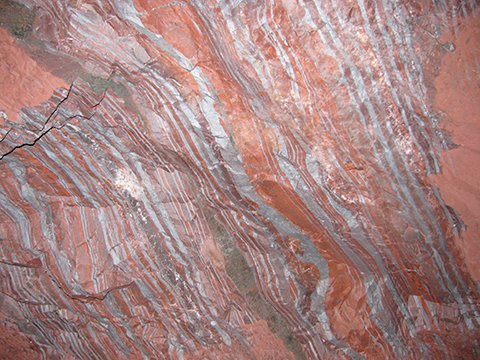


+
QUARTZITE
Quartzite
Not long after mountains were uplifted across central Minnesota, sand began to accumulate in braided streams in southwestern Minnesota. These stream deposits of reddish quartz sand grains were eventually consolidated and slightly altered into a very hard rock called quartzite.
The reddish to purple Sioux Quartzite is at the surface near Blue Mounds State Park and the Jeffers Petroglyphs in southwestern Minnesota. At Pipestone National Monument, a thin mudstone layer is sandwiched between thick layers of quartzite. This mudstone layer is pipestone (catlinite), and is spiritually significant to Native Americans, who have carved it for centuries.
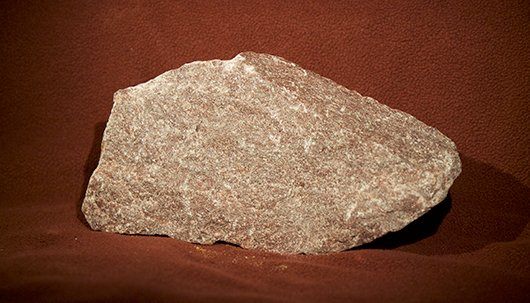

+
BASALT
Basalt
About 1.1 billion years ago, the continent that had been building for billions of years began to split apart across what is now Minnesota. The "Midcontinent Rift" is where the crust began to separate to form a new ocean basin. The same process is currently underway between the African continent and Saudi Arabia. The rifting process stopped short of producing a new ocean basin in central North America, but the abundant dark red-brown basaltic rocks now exposed along Lake Superior's North Shore are a testament to the massive outpouring of lava through fractures or cracks along the rift. Gooseberry Falls State Park is an ideal place to explore these ancient lava flows.

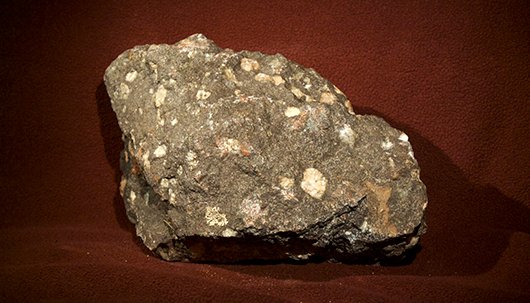
+
GABBRO
Gabbro
Gabbro is a silica-poor and Fe-Mg-rich intrusive rock formed when molten rock is trapped beneath the land surface and cools into a hard, coarsely crystalline mass. It is the intrusive equivalent to basalt. Minnesota's best examples of gabbro are in the part of the 1.1 billion-year-old Midcontinent Rift exposed in the large hills in and north of Duluth, known as the Duluth Complex.
The rock is dense, dark-colored, and contains varied percentages of the minerals plagioclase, pyroxene, and olivine. The Duluth Complex contains extensive, low-grade deposits of copper, nickel, and platinum group elements.


+
AGATE
Agate
Minnesota's state gemstone is the Lake Superior agate—so named because it is found predominantly along the shore of Lake Superior. Agates formed in cavities in basalt. As mineral-rich water circulated through the cavities, silica (SiO2), or quartz, was deposited in layers along cavity walls. Eventually, the cavities completely filled with this banded variety of quartz. The color variations are due to slight mineral impurities in the water. Iron, for example, caused much of the red and orange color seen in Lake Superior agates.
Although agates originated in the basaltic rocks along the North Shore, some of the best places to hunt for agates are in gravel pits scattered across the state. Specifically, agates are likely to be found where operators are mining glacial sand and gravel deposits associated with glaciers that advanced into Minnesota from the northeast, bringing agate-bearing gravel into the central and southern parts of the state.


+
ANORTHOSITE
Anorthosite
Similar in composition to rocks on the moon, anorthosite is a coarse-grained, intrusive igneous rock composed almost entirely of a single mineral—plagioclase feldspar.
In Minnesota, anorthosite was intruded into the lowermost lava flows that formed during the opening of the Midcontinent Rift. Anorthosite is part of the Duluth Complex and the closely related Beaver Bay Complex exposed along the North Shore of Lake Superior. Split Rock Lighthouse sits atop an outcrop of anorthosite.
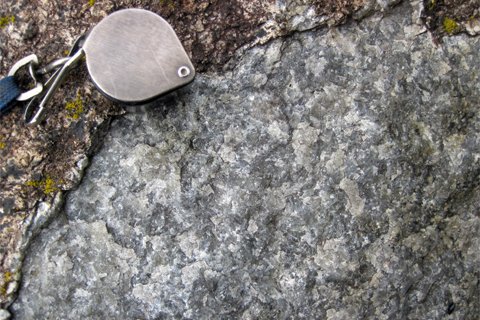

+
SANDSTONE
Sandstone
In Minnesota, sandstone and other sedimentary rocks were deposited during the early Paleozoic Era, about 500 million years ago. At that time, Minnesota was near the equator, and shallow seas covered most of the state. Sediment eroded from upland areas was transported to the seashore, and the coarser-grained sediment eventually formed the sandstones seen today in southern Minnesota. Some of these sandstones are so poorly cemented that the grains can be rubbed off with your finger. As the sandstone is eroded, piles of clean quartz sand are formed.


+
LIMESTONE AND DOLOSTONE
Limestone and Dolostone
Further offshore, away from sandy areas, finer-grained sediment accumulated and chemical sediment precipitated to form limestone and a closely related rock called dolostone. In this environment, marine life was abundant. Shells and skeletons of various clams, snails, corals, and other animals are preserved in the limestone of southern Minnesota. Limestone is typically tan to gray. It may be massive or bedded in layers with sandstone and shale. In places, fossils can readily be found.
Many quarries in southern Minnesota mine and crush limestone for material needed to make concrete and asphalt for buildings and roads.


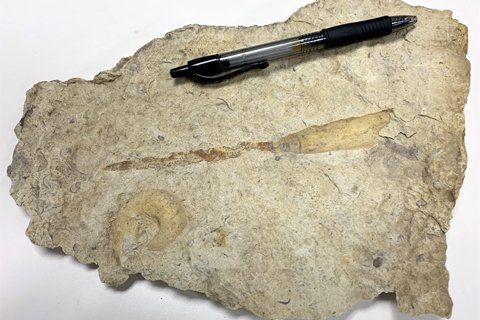
+
SHALE AND MUDSTONE
Shale and Mudstone
We know from observation along modern coastal zones that fine-grained silt and clay are deposited in calmer water, away from the high-energy shoreline. The same situation existed along ancient coastlines. These muddy sediments eventually form shale and mudstone. The Paleozoic shale layers in southeastern Minnesota are thin and inconspicuous. The rock is soft, gray to greenish-gray, splits into ragged chips, and converts easily back to mud when soaked in water. Shale of Cretaceous age (about 80 million years old) is used to make bricks and tiles near Springfield.

+
GLACIAL DEPOSITS (UNCONSOLIDATED ROCKS/SEDIMENT)
Glacial Deposits (Unconsolidated Rock/Sediment)
Above Minnesota's rocks are sediments, mostly glacial sediments that were deposited relatively recently, within the last 2 million years, when ice repeatedly covered the state. Glaciers passed over all the various rocks described here and ground them up. Those sediments, now particles of gravel, sand, silt, and clay, are distributed in a thick blanket that covers most of Minnesota's underlying bedrock. When you pick up a rock almost anywhere in the state, the chances are good that it has been transported from somewhere else by glaciers.
Although not a rock today, the glacial debris that covers much of the state may eventually become consolidated into a rock called diamictite. The process will probably take hundreds of thousands of years, and during that time, the processes of weathering will continue to erode and modify the surface that we see today.

Additional Content
+
Classroom Materials & Additional Reading
Classroom Materials
Interactive Digital Slideshow
- The Virtual Egg Carton: A virtual resource to rock types commonly found in Minnesota
Additional Reading
MGS Publications
+
Page Sources
- B.A. Lusardi, 2000, Minnesota at a Glance: Common Minnesota Rocks: Minnesota Geological Survey; revised by B.A. Lusardi, 2020; modified for web by A.J. Retzler, August 2020.